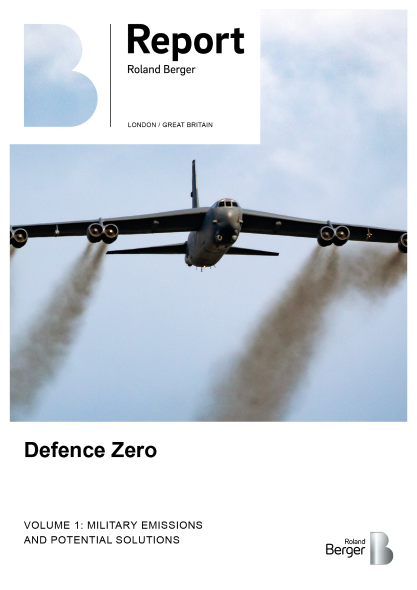Defence Zero
![{[downloads[language].preview]}](https://www.rolandberger.com/publications/publication_image/Roland_Berger_INS_1058_Defence_Zero_DT_download_preview.png)
Volume 1: Military emissions and potential solutions


By Adam Healy
"At a time when the effectiveness and value for money of Defence is firmly in the spotlight, we need decisive and collective action to drive a critical change."
Between 1% and 5% of global CO2 equivalent emissions are estimated to come from Military and Defence industry activities—this is according to recent studies by different stakeholder groups.
At Roland Berger, our calculations suggest that the Defence sector releases to the atmosphere emissions on the order of 500 megatons to 1 gigaton of CO2 equivalent annually, implying that it contributes between 1% and 2% of global anthropogenic emissions. Of this sum, approximately 65–70% stems from the operation of military platforms and ~30% from stationary assets, with the remaining share coming from the supply chain for military equipment. Part of these emissions are sequestered by the vast amounts of land owned by the military.
In this study we investigate how emissions from assets owned by the Defence sector—both mobile and stationary—aggregate to produce the overall footprint and emissions profile of militaries, based on the mix of assets owned by armies, air forces, and navies. Then we break down emissions from air, sea, and land platforms to identify the contributions of supply chain (~3%) and operations (~97%), showing that the number of active platforms, and how they are used, are the main drivers of military emissions.

The magnitude of the problem and main emissions drivers
Defence generated over 500 Mt CO2e in 2019, accounting for ~1.1% of total global emissions. These emissions were mainly distributed among air forces (~20–25%), navies (~30–35%), and armies (~30–35%), with a small proportion coming from other military bodies, such as border patrols and coast guards. Whilst the footprint of air forces and navies is driven by emissions from air and sea platforms respectively, armies’ footprint is dominated by emissions from bases and other stationary assets, whilst a country’s emissions profile may vary significantly depending on whether or not it is actively engaged in a war. From the more than 500 Mt CO2e generated by Armed Forces globally, approximately one third is likely to be sequestered by the vast amount of land owned by the military (2–3%of the world’s total land).
Defence’s share of global emissions is comparable with that of civil aviation and maritime transport. However, military emissions could contribute up to 5% of the global footprint (as referenced in the aforementioned Nature paper), placing Armed Forces footprint over the level of cement production.

In terms of asset types, ~70% of the emissions footprint was produced by mobile assets, or platforms, whilst ~30% stemmed from stationary assets. ~97% of emissions from mobile assets are generated during the operation of military platforms, which are mainly driven by the high number of moderately emitting active assets—as is the case of the Army’s land vehicles—or by the operation of a lower number of highly-emitting vehicles, such as the air and the sea platforms of the Air Force and the Navy. Although emissions from the production of military platforms delivered to Armed Forces in a given year—mainly driven by the materials selected for the platforms—are a relatively small share (~3%) of overall platforms’ emissions, OEMs and their supply chains have the potential to influence both emissions generated in the production of equipment and those produced during the operation of equipment by Armed Forces.

An example in the potential of the supply chain to influence platforms’ operation emissions is illustrated by the industry’s transition from mainly metallic fighter jets to aircraft built using composites as the principal structural material. This transition increased the embodied emissions of new generation fighters by ~30%, but significantly reduced their operational emissions (by up to 50%). This example demonstrates well that an integrated, collaborative approach involving both supply chain and end user stakeholders is required to reduce emissions, and that both must be tackled to drive sustainability in the sector.
A way forward for a sustainable Defence sector
The Defence industry, representing 1–2% of global emissions today, will be one of the most difficult to decarbonise. Mitigating the more than 500 MtCO2e generated annually by the sector—most of which stems from the operation of military platforms—must not come at the expense of operational effectiveness. But using the many levers available to them, end users and their supply chains can drive evolutionary and revolutionary change, improving efficiency, reshaping operations,and switching to new technologies. Indeed, the concept has already been demonstrated through the transition from mainly metallic airframes to composite aerostructures for combat aircraft, thereby reducing fuel consumption (and therefore emissions) whilst simultaneously improving performance. At a time when the effectiveness and value for money of Defence is firmly in the spotlight, we need decisive and collective action to drive a critical change.

![{[downloads[language].preview]}](https://www.rolandberger.com/publications/publication_image/Roland_Berger_INS_1058_Defence_Zero_DT_download_preview.png)
Volume 1: Military emissions and potential solutions